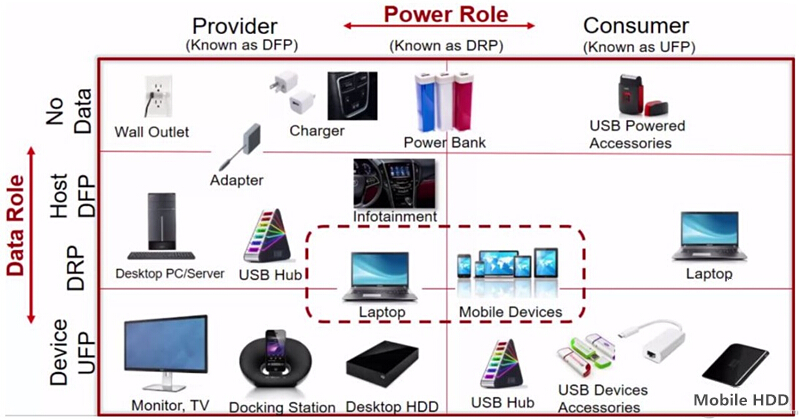Data Role of Type-C
On the USB 2.0 port, USB defines three roles of HOST/Device/OTG according to the direction of data transmission. Among them, OTG can be used as HOST or as Device. In Type-C, there are similar definitions, but the name has a little modification. As follows:
(1)DFP(Downstream Facing Port):
The downlink port can be understood as Host or HUB. DFP provides VBUS and VCONN and can receive data. In the protocol specification, DFP refers to the downlink transmission of data. In the general sense, it refers to the equipment for data downlink and external power supply.
(2)UFP(Upstream Facing Port):
The uplink port can be understood as Device. UFP takes power from VBUS and can provide data. Typical devices are USB flash drives and mobile hard drives.
(3)DRP(Dual Role Port):
Dual role port, similar to the previous OTG, DRP can be used as DFP (Host), UFP (Device), or dynamically switch between DFP and UFP. A typical DRP device is a laptop. The role of the device when it is just connected is determined by the Power Role of the port (refer to the introduction below); it can also be changed later by the switch process (if the USB PD protocol is supported).
Power Role of Type-C
According to the power supply (or power receiving) of the USB PORT, the USB Type-C divides the port into power roles such as Source and Sink.
The following figure shows the Data Role and Power Role of common devices.

Power Role can be divided in detail into :
a)Source Only
b)Default Source, but occasionally can switch to SINK mode via PD SWAP
c)Sink Only
d)Default SINK, but occasionally can be switched to Source mode via PD SWAP
e)Source/SINK rotation
f)Sourcing Device (Powered Device, Display)
g)Sinking Host(Power operated Host, Laptop)

